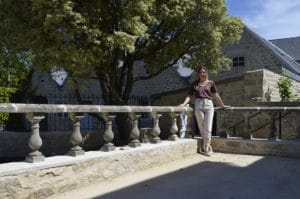" In the case of the Alexis Le Gall cannery museum project, I think we can talk more about heritage than about heritage, because the Loctudy cannery was more a women's business. Ninety percent of the factory's staff are women and two thirds of the trio at the head of the cannery are women. What is important to me in this project is to restore the memory of all these women, whether they were workers or the two bosses. I think it is very important to tell this story. The memory of the men of the coast has already been told on many occasions within different museum structures. However, this is not the case for the memory of the women of the coast. "Marie Prigent-Viegas, heritage curator
After starting her career as a heritage curator attached to museum institutions, Marie Prigent Viegas decided to practice her profession as an independent. This newfound freedom allows her to participate in the implementation of very diverse and original museum projects, such as the museum project of the Alexis Le Gall cannery in Loctudy, on which she has been working since its launch in 2016. Passionate about historical research and the ethnographic approach to museums, this heritage curator has put her professional rigour at the service of the cannery project.
his background professional
I started by studying art history. I then completed my university studies with a course in cultural project management. My studies took me from Quimper to Rennes, then from Rennes to Paris. When I arrived in the capital, I started by working for large national museums such as the Louvre. I then came back to Quimper to work at the Museum of Fine Arts. After a while, I realised that fine arts were not necessarily what I was most passionate about in my job. I realised that museums of society spoke to me more because of their ethnographic approach, centred on the human and the sensitive. Following this, I worked for museums focusing on maritime issues, such as the fishing museum in Concarneau. I also directed the Bigouden museum in Pont-l'Abbé for several years.
After a few years at the Bigouden Museum, I decided to take a new turn and to work as a freelance heritage curator. My missions are similar to those of a heritage curator attached to a museum or cultural institution. The difference is that I am free to participate in more diverse projects and to carry out assignments for several institutions at the same time. This allows me to work for municipalities that would not necessarily have the will or the budget to hire a permanent heritage curator. I also work on projects such as the Alexis Le Gall cannery museum in Loctudy, which are driven by a strong local political will.
its notion of Heritage
In the case of the Alexis Le Gall cannery museum project, I think we can talk more about heritage than about heritage, because the Loctudy cannery was more a women's business. Ninety percent of the factory's staff are women and two thirds of the trio at the head of the cannery are women. In fact, alongside Alexis Le Gall, his wife Alice Bouville and his daughter Henriette Le Gall have been involved in the management of the family business from the beginning to the end. What is important to me in this project is to restore the memory of all these women, both the workers employed in the factory and the two bosses. It is very important to tell this story. The memory of the men of the coast has already been told on many occasions within different museum structures. This is not the case for the memory of the women of the coast. One of the few representations that is currently conveyed is that of the fisherman's wife, who waits for the return of her man at the end of the pier.
With this project, it is possible to tell another story of the life of women on the Breton coast. This museum project tells the story of how women lived on land and provided for their families through this activity. It also puts things in the right order from a historical point of view. The canneries did not come to the coast because there were fishermen. It was the fishermen - originally from inland - who came to the coast and started fishing, because canneries had been established along the coast. Of course, the owners and investors were men, but the ones who wore out their skirts on the cannery benches and froze their feet in the cold water were women. It is important to underline this and it is essential to pass on the memory of all these women workers who participated in the economy as much as they contributed to shaping the history of this territory.
Its role in the of the museum project
I was involved very early on in the museum project of the Alexis Le Gall canning factory. I was initially asked, along with Amélie Garrot-Hascoët, to write the museum's scientific and cultural project. We wrote this document five years ago, in the summer of 2016. Part of this document was devoted to the prefiguration of the future museum. The latter was characterised by a reflection on the administrative, legal, economic and political form that the establishment should take.
In a second phase, we were both mobilised in 2018 on the collections project. This consisted of making an inventory of all the objects on the industrial site, which had been classified as Historic Monuments. Within the framework of this mission, we also set up a preventive conservation protocol (dusting, marking, photographic recording, etc.).
Since these first two missions, I have followed the evolution of the project throughout the following phases, whether during the restoration of the objects with professionals (cabinetmaker, steam engine specialists and crimpers) or the development of the museography. In particular, I wrote all the texts, which were integrated into the museum's scenography and audio guides. To do this, I carried out archival and iconographic research in order to flesh out and illustrate the museum's discourse. The objective was to be able to reconstruct the history of the cannery, beyond the few testimonies we had when the project started.
For certain historical points, it was more complicated to find traces. For this, I collaborated with the historian Serge Duigou, a specialist in the history of the Bigouden region and in particular Loctudy. I also asked people who had worked in Breton canneries, either at the time the Loctudy factory was in operation, or at later times. I also asked members of the Association of Friends of the Alexis Le Gall Cannery to help me with this.
its great challenges
The great challenge concerning the Loctudy cannery concerns the fact that it is a former industrial site of modest size, many of whose objects were cobbled together from heterogeneous and disparate elements, but whose building and all of the objects in it have been classified as Historic Monuments. This classification implies respecting a certain regulatory procedure - relatively strict and rigorous - in the way the site and its collections are approached and treated. In France, the respect of the protocol relating to museums implies finding the right balance in this treatment. We have to know how far to go in terms of ethical and scientific requirements and rigour, but also in terms of the respect we owe to this heritage and its conservation, i.e. all the preventive measures necessary to prolong the life of this heritage object. Preventive conservation is characterised by a strict regulatory procedure, which in some cases would require more flexibility, particularly for elements made up of "bricks and mortar".
its best souvenir
My fondest memory is the moment I entered the cannery for the first time, and the emotion that gripped me. I had the feeling of entering a place untouched by time, a jewel in the rough. It was only later that I realised that the place had been restored by its former owner, notably for the Heritage Days in the 1990s, and that several modifications had been made over the years. Despite this, my first impression, the emotion I felt when I first discovered the cannery, remained intact.


